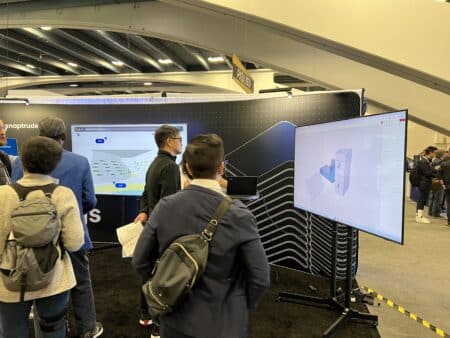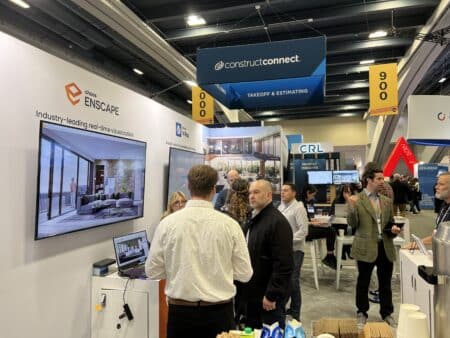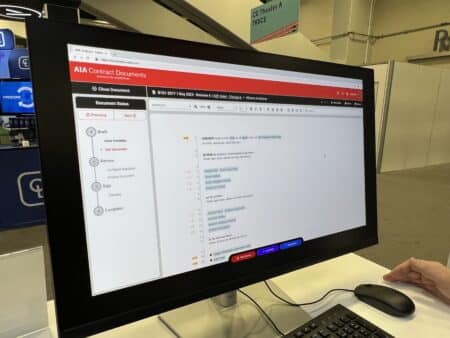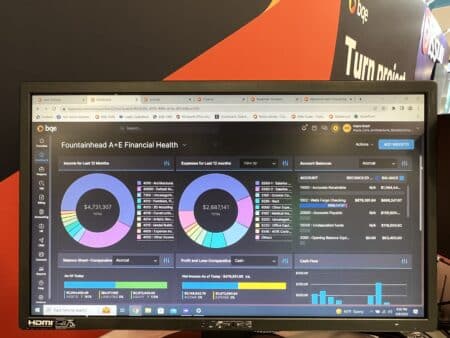The Software and Tech Pavilion at AIA 23 San Francisco this year had nearly 38 companies showcasing their latest digital technologies for architects. Some folks do set up outside the Pavilion—never a pleasure for us as we have to trek a bit to their booths, making our ultra-tight schedule of appointments even harder. We manage.
Day 2
On Day 2 (Friday), Architosh visited several vendors, many just by stopping by. But we did have some continued appointments. We will start off this report with some BIM 2.0 era newcomers that have never been to the AIA National Convention before. Both Snaptrude and Skema are promising new solution providers solving existing pain points in innovative new ways and exposing architects to new ways of thinking about solving design problems and new ways of working together.
Snaptrude
We are going to do a dedicated article on Snaptrude’s experience at AIA 23 San Francisco and what Snaptrude is all about. So this section right here will be a bit brief.
What is Snaptrude?
Snaptrude V1.0 was released back in December of last year and is technology self-described as a milestone “cloud-era platform for architecture.” Snaptrude is operating fully in the web browser and thus is independent of operating systems like macOS and Windows. This means users can run it wherever they are—home or office on whatever computer they have access to. At the booth at AIA 23, Snaptrude was often running on the new Arc web browser on a MacBook computer. So what is Snaptrude for?

The Snaptrude booth at AIA23 was quite busy, with visitors intrigued by witnessing a SketchUp-like tool environment with parametric capabilities.
At first blush, Snaptrude looks a lot like SketchUp. And in truth, Snaptrude is meant to be a conceptual design tool. You can start conceptualizing your design in similar ways to working in SketchUp. The big difference, however, is that Snaptrude’s modeling engine is set up to enable rapid automation and parametric modeling. There is a feature called Sketch to BIM, for example, that was shown to me at the booth, and it was very impressive. Snaptrude is also built with data in mind from the ground up, so it can help users with automated BoQs (Bills of Quantities) for cost estimation, for example. Snaptrude is multi-user capable, so more than one person can be working on the model at the same time. (more on this later). And Snaptrude can work with Autodesk Revit.
We will do a deeper dive into Snaptrude at AIA 23 in an upcoming report. (stay tuned!)
Skema
Back in May, we wrote about Skema from Blue Ocean. Blue Ocean is both UK and US-based and has three leaders, two of whom I met. Charlie Cichetti is CEO and Co-Founder and is a leader in the green building industry and the only one of the three I did not meet at AIA 23. The other leaders are Kristina Bach and Marty Rozmanith. Much like Charlie, Kristina has extensive expertise in green building design and is President and Co-Founder. Marty Rozmanith is another partner and is best known in the industry for being a key member of the original Revit development team prior to Autodesk’s acquisition of Revit. He is a wealth of information about Revit’s beginnings and its technical underpinnings.

The Blue Ocean booth with Skema was very well-attended with lots of interest from architects looking to learn about Skema’s capabilities.
So Skema is another BIM 2.0 era tool that delivers design automation at the earliest stages of a project. It helps architects rapidly investigate building site placement, context, massing, blocking, stacking, and sustainability, all in one set of sequenced processes. And it can produce proforma metrics.
Marty demoed Skema for me, starting with an overall building shape, then defining the circulation in the building, and then Skema automatically filled in the rest of the building with apartment units of various sizes and configurations. These apartment or residential units can be defined in advance with parameters (like size), and Skema has a “solver” that can generate a multitude of possible building layouts in 3D, solving for various proportional mixes. Skema can then send its resultant generative models to Revit for further work.
There is a lot more we can say about Skema, so look for a deeper report here on Architosh soon.
Enscape – Chaos
In 2022 Chaos merged with Germany’s Escape to create a visualization software company with over 700 employees worldwide. Both Enscape (currently at version 3.5) and V-Ray software was fully on display in their very popular booth at AIA23. Enscape version 3.5 is the most recent update to the popular real-time visualization tool and features a new global illumination algorithm, support for Revit 2024 several improved features having to do with editing and setting assets in a scene.

The Chaos and Enscape booth at AIA was a popular stop for show-goers. Enscape, in particular, continues to garner attention as the easy-to-use rendering plugin brings real-time, interactive rendering to your BIM or design modeling application of choice.
Meanwhile, V-Ray 6 is the latest version of the popular high-end photorealistic renderer that operates as a plugin to host applications. V-Ray 6 for Revit is arguably the premium visualization toolset for the world’s most popular BIM platform. V-Ray has gained Escape’s procedural cloud technology as a premium benefit of the new merger between the two companies. There is also new decal technology and the ability to bridge between using Enscape and V-Ray as part of one singular workflow in a solution known as “Enscape to V-Ray Bridge.”

Enscape and Chaos at AIA23. The folks at the Chaos – Enscape booth were also showing Enscape to V-Ray Bridge tech and several other recent improvements.
As we noted in our BEST of SHOW award report, there is new exciting technology coming to Enscape, including BIM pre-flighting and IES for energy integrations.
AIA Documents + Analytics
I spent some time in the AIA Documents booth talking to Dean Geib about the new version of AIA Documents that is fully cloud-based. No longer is the solution tied down to Microsoft Word in any way. AIA Documents are now powered by Catina, a digital platform company that has partnered with AIA to truly bring about a modernization of the trusted industry legal contract standards in the United States.
Back in 2020, the AIA and True Wind Capital (TWC), a leading private equity firm, formed a strategic partnership. A new entity called Catina is now the producer of the AIA Documents in concert with the AIA itself, and Catina is led by CEO Chris Anderson, the former CEO of Building Systems Design (BSD), a provider of specification software and content for the industry.

Years ago, when Architosh covered the AIA show, we heard year after year that someday, AIA Documents would be fully platform-independent. That day has finally arrived in 2023 with the new Catina-powered cloud-based AIA Documents software platform. But what is happening with Catina and the AIA is so much more than platform independence.
Aside from Catina taking the AIA Documents platform to entirely new cloud-only technology—which means liberation from integration with Microsoft Word—Catina will be delivering data analytics solutions as part of its overall AIA Documents offerings. Dean Geib, who is the chief strategy officer. Geib’s background includes a role as Manager of Standards and Specifications at Walt Disney Imagineering. The new analytics solutions being developed by Catina as part of AIA Documents offerings will include Risk Analytics. These will help architects understand so much more about their projects and operations, such as which building systems impact COs (change orders) the most. With the AIA Documents inside a modern cloud (SaaS) infrastructure, high-level machine learning (ML) AI can analyze data and provide insightful knowledge as part of KPIs (key performance indicators). This was not possible before when AIA Documents were tied down into file-based Word documents.
One of the most impact examples of this is being able to see which building systems impact COs the most. From the dashboard example shown to me, Interior Finishes were producing 21 percent of all COs. On the other hand, HVAC was producing only 5.13 percent. This data is useful because architects can derive from it that more effort or changed processes should be developed to reduce COs for things like interior finishes, which happen later in the project’s construction schedule when changes are most costly. The bottom line is that AI-powered analytics are coming to an all-new platform this year from AIA Documents powered by Catina. You can learn more here.
BQE
Less than 50 percent of architecture firms use specific AE industry financial management software solutions. A great many smaller architecture firms use horizontal financial accounting tools like Intuit’s QuickBooks or some similar application, of which there are many now, including the well-regarded Xero, Wave, and Freshbooks. But these tools are not purpose-built for the AE industry, providing architects in a particular comprehensive financial firm and project health oversight.
Last year we went through several of these AE financial tools in our AIA22 show reports. This year we have awarded an AIA23 Architosh BEST of SHOW honor to BQE, which you can read about here. BQE Core serves architects by delivering a cloud-based financial tool built specifically for the needs of architects and engineers with KPIs specific to the AE industry. General financial tools like QuickBooks don’t tell architects if they are over or under budget on a project, and they certainly can’t tell you that at a glance.

A view of the new dark mode for the user interface for BQE Core. A quick glance at dashboards helps architects immediately gauge their firm’s financial health and project-by-project health.
BQE Core delivers true Project Accounting so you can know where you stand financially on each and every project. Dashboard graphics help you understand key metrics like employee utilization rates, total time and expenses on a project, and resource allocations. Employees track their time card data inside BQE Core, plus expenses, and they can do most functions on dedicated mobile apps for both Android and Apple iOS smartphones. As part of its Project Management tools, I was impressed with the new Gantt charts in BQE Core. The latest version also includes a new dark mode for the user interface. BQE can integrate with general accounting tools, so firms can still utilize general accounting software solutions in tandem with BQE Core. BQE Core can handle multiple methods for how architects create fee structures, from hourly rates to the percentage of construction and combinations of fee structures on a single project.
BQE Core competes with older industry stalwarts like Deltek and newer all-cloud solutions like Unanet, FactorAE, and Monograph.



Reader Comments
Comments for this story are closed